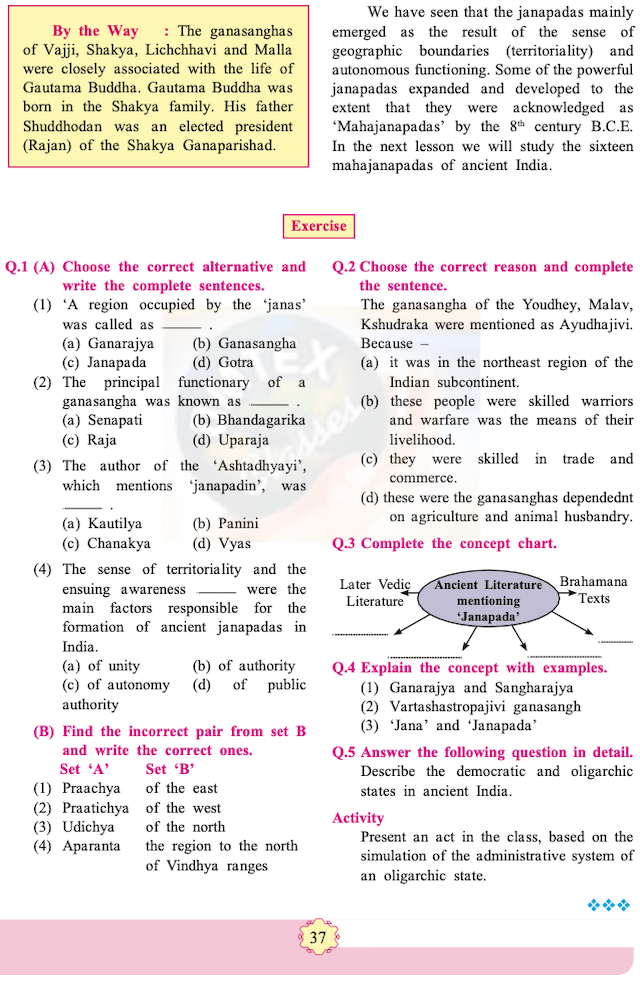Chapter 5: Janapadas and Republics
Choose the correct alternative and write the complete sentence.
‘A region occupied by the ‘janas’ was called as ______.
OPTIONS
Ganarajya
Ganasangha
Janapada
Gotra
SOLUTION
‘A region occupied by the ‘janas’ was called as Janapada.
The principal functionary of a ganasangha was known as ______.
OPTIONS
Senapati
Bhandagarika
Raja
Uparaja
SOLUTION
The principal functionary of a ganasangha was known as Raja.
The author of the ‘Ashtadhyayi’, which mentions ‘janapadin’, was ______.
OPTIONS
Kautilya
Panini
Chanakya
Vyas
SOLUTION
The author of the ‘Ashtadhyayi’, which mentions ‘janapadin’, was Panini.
The sense of territoriality and the ensuing awareness ______ were the main factors responsible for the formation of ancient janapadas in India.
OPTIONS
of unity
of authority
of autonomy
of public authority
SOLUTION
The sense of territoriality and the ensuing awareness of autonomy were the main factors responsible for the formation of ancient janapadas in India.
Find the incorrect pair from set B and write the correct ones.
SOLUTION
Choose the correct reason and complete the sentence.
The ganasangha of the Youdhey, Malav, Kshudraka were mentioned as Ayudhajivi. Because –
OPTIONS
it was in the northeast region of the Indian subcontinent.
these people were skilled warriors and warfare was the means of their livelihood.
they were skilled in trade and commerce.
these were the ganasanghas dependent on agriculture and animal husbandry.
Complete the concept chart.
Explain the concept with examples.
Ganarajya and Sangharajya
SOLUTION
'Gana' means the ruling class comprising members of equal social status.
Similarly, 'sangha' means a state formed by many kulas or janapadas by coming together.
By 6th century B.C.E. many sangharajyas had come into existence.
There were three main types of the ancient federation of states in India :
Ganarajya of the members of the same kula. For example, Malava and Shibi.
Ganarajya created by more than one kulas coming together. For example, Vajji Ganasangha. It included eight kulas. Vajji, Lichchhavi, Dnyatruk, and Videha were the important ganas among them.
More than one ganrajyas coming together to create a sangharajya. For example, YaudheyaKshudrak Sangh.
Vartashastropajivi ganasangh
SOLUTION
Ancient Indian literature mentions two more types of ganasanghas.
'Ayudhjivi' Sangh and 'Varta-Shastropajivi' Sangh.
'Varta' means trade and commerce.
The people in the VartaShastropajivi ganasanghas lived by trade and commerce, agriculture, and animal husbandry, as well as their skills in warfare.
People in the Kamboj and Surashtra ganasanghas earned their livelihood by these means.
‘Jana’ and ‘Janapada’
SOLUTION
Vedic people used the term Jana to designate a group of people, united under a common bond of singular kinship structure.
Their settlement was known as 'Grama'.
A cluster of gramas consisting of the same Jana was known by the name of that particular Jana.
A region occupied by a Janas was called as Janapada.
Gradually the Janapadas had more formal administrative structures transforming them into independent states.
These were the first well-established states of ancient India.
However, this does not necessarily mean that every Janapada evolved into an independent state.
Answer the following question in detail.
Describe the democratic and oligarchic states in ancient India.
SOLUTION
Democratic States :
Some of the ganasanghas were divided into regional zones called 'Khanda'.
They functioned through a group of elected individuals, who were found capable.
Each of the elected members represented his respective khanda.
These elected members were installed with collective authority for the smooth running of the ganasangha.
This was a democratic system. Ganasanghas which functioned in this democratic way existed in Punjab and Sindh at the time of Alexander's invasion.
Each elective representative of the respective regional zone was designated as 'Ganamukhya'.
Every ganamukhya was a member of the assembly known as 'Gana Parishad'.
The decisions made by the Gana Parishad were implemented by designated functionaries of the various cadre.
He was known as the 'Adhyaksha' or 'Raja'.
Oligarchic States :
In this type, the elite class in the society held all the powers of decision-making and administration.
Panini and Kautilya mention them as 'Rajshabdopajivi' Sangh.
Panini includes Vajji, Andhaka, Vrishni, Yaudheya in the Rajashabdopjivi type.
Kautilya includes the Vrijji or Vajji, Madrak, Kuru, Panchala, etc. in this type.
This type of ganasanghas were more prevalent in the eastern region of Uttar Pradesh and Bihar.
Balbharati Solutions for History 11th Standard Maharashtra State Board
• Chapter 2: First Cities of India
• Chapter 3: Chalcolithic Villages in India
• Chapter 5: Janapadas and Republics
• Chapter 6: Second Urbanisation in India
• Chapter 7: India and Iran (Persia)
• Chapter 8: India during Mauryan period
• Chapter 9: Post Mauryan India
• Chapter 11: Kingdoms in South India
• Chapter 12: India, Nations in the northwest of the Indian Subcontinent and China
• Chapter 13: India, Shri Lanka and Southeast Asia
• Chapter 14: Delhi Sultanate, Vijayanagar and Bahamani Kingdom
• Chapter 15: India during Mughal period
• Chapter 16: Swarajya to Empire (Maratha period)
.





